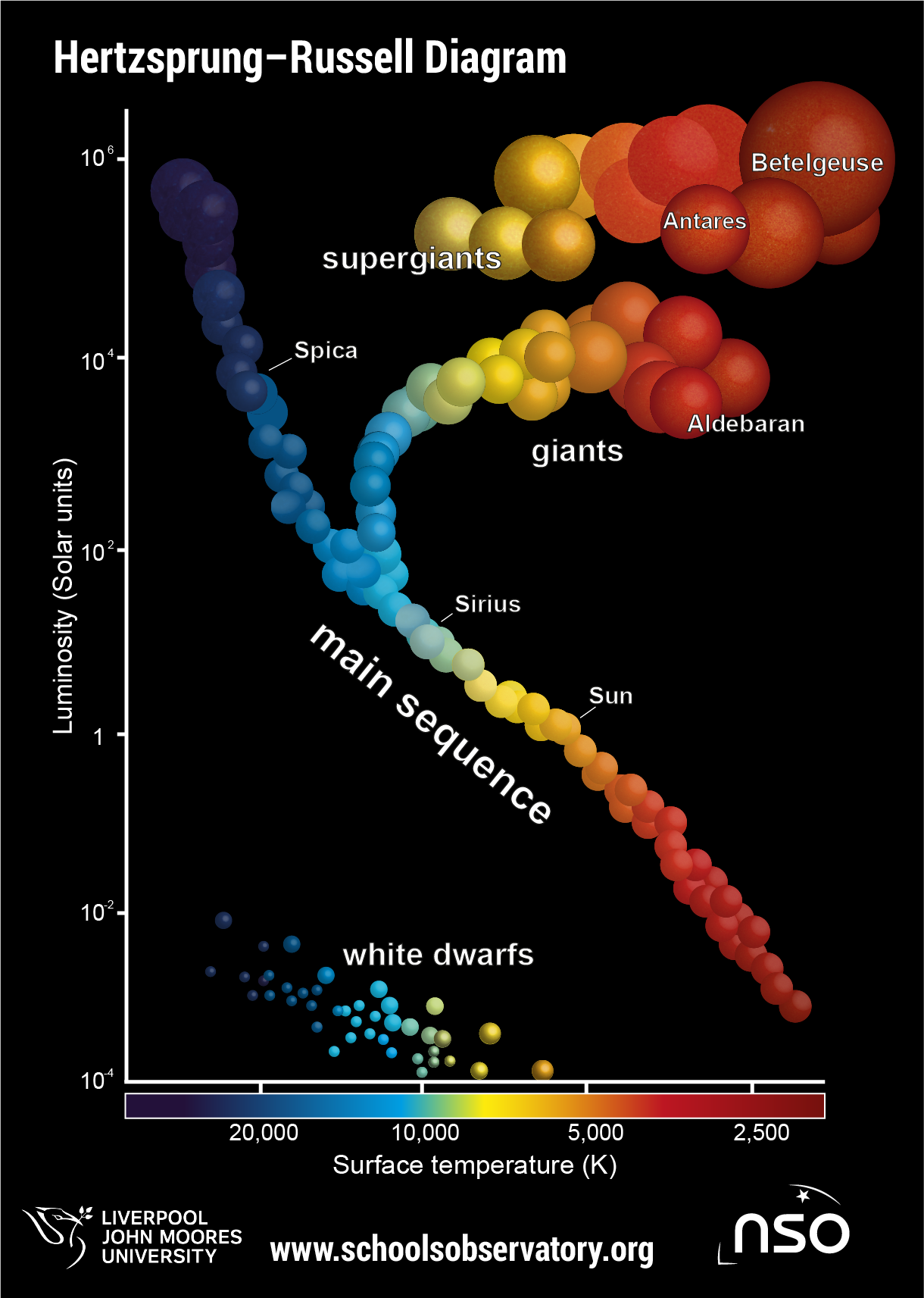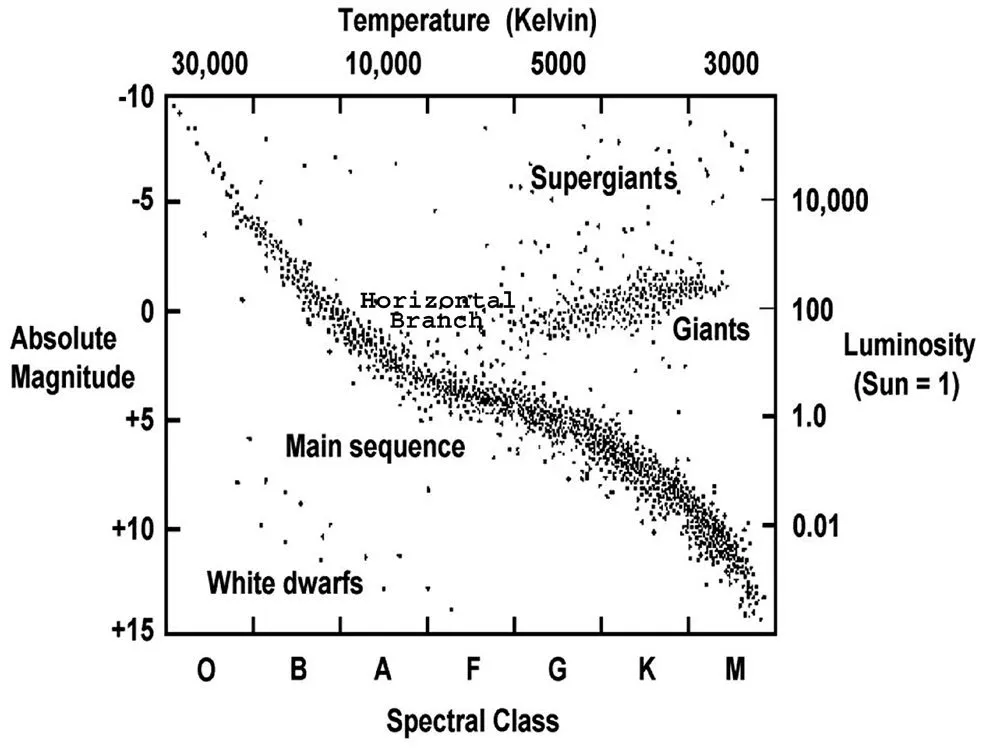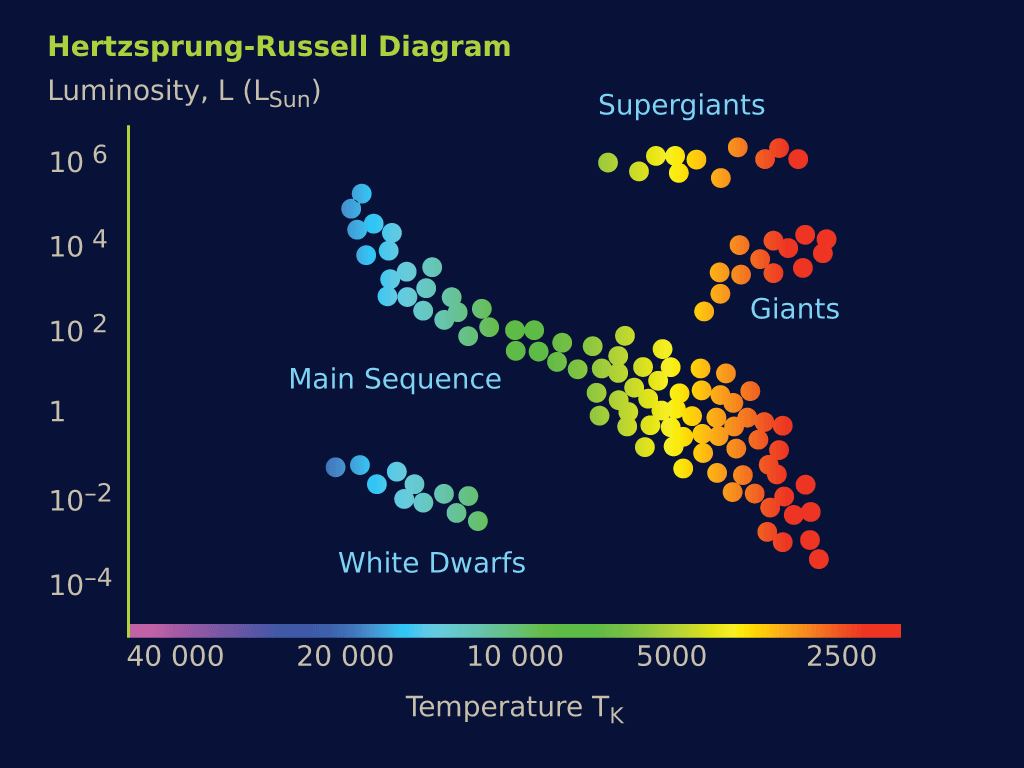How To Read Hertzsprung Russell Diagram
How To Read Hertzsprung Russell Diagram - Web following hertzsprung and russell, let us plot the temperature (or spectral class) of a selected group of nearby stars against their luminosity and see what we find ( figure 18.14 ). Once we know the current age of a star and its location on the diagram, we can accurately predict its fate over the. Web spectral types and stellar classification. The sun lies near the middle of the main sequence on the diagram. Stars are classified by their temperatures and luminosities. Web diagram that you will normally encounter plots the luminosity of a star (in solar luminosity units, l sun) versus its temperature (or spectral type). It is an important astronomical tool for understanding how stars evolve. Developed independently in the early 1900s by ejnar hertzsprung and henry norris russell, it plots the temperature of stars against their luminosity (the theoretical hr diagram… The most important graph in astrophysics if you truly want to understand modern astrophysics, knowing how to read this graph is. Web figure 1 hertzsprung‐russell diagrams.
The positions of the various main types of stars are labeled in this hr diagram… Web spectral types and stellar classification. The spectral class of a star denotes its temperature, with o stars. Web diagram that you will normally encounter plots the luminosity of a star (in solar luminosity units, l sun) versus its temperature (or spectral type). It shows stars according to their temperature and brightness. Stars are classified by their temperatures and luminosities. Developed independently in the early 1900s by ejnar hertzsprung and henry norris russell, it plots the temperature of stars against their luminosity (the theoretical hr diagram… The most important graph in astrophysics if you truly want to understand modern astrophysics, knowing how to read this graph is. The general labeling of stars into four groups is shown. An example is shown here:
The most important graph in astrophysics if you truly want to understand modern astrophysics, knowing how to read this graph is. The general labeling of stars into four groups is shown. Web diagram that you will normally encounter plots the luminosity of a star (in solar luminosity units, l sun) versus its temperature (or spectral type). It shows stars according to their temperature and brightness. Web figure 1 hertzsprung‐russell diagrams. Once we know the current age of a star and its location on the diagram, we can accurately predict its fate over the. The sun lies near the middle of the main sequence on the diagram. Developed independently in the early 1900s by ejnar hertzsprung and henry norris russell, it plots the temperature of stars against their luminosity (the theoretical hr diagram… The spectral class of a star denotes its temperature, with o stars. The positions of the various main types of stars are labeled in this hr diagram…
HertzsprungRussell Diagram National Schools' Observatory
Web spectral types and stellar classification. Once we know the current age of a star and its location on the diagram, we can accurately predict its fate over the. Developed independently in the early 1900s by ejnar hertzsprung and henry norris russell, it plots the temperature of stars against their luminosity (the theoretical hr diagram… Web following hertzsprung and russell,.
HertzsprungRussellDiagram Ripon Common Sense
The sun lies near the middle of the main sequence on the diagram. Once we know the current age of a star and its location on the diagram, we can accurately predict its fate over the. Nearby stars and some of the brighter stars in the sky have been added, with the positions of a few well‐known. An example is.
The HertzsprungRussell Diagram
An example is shown here: Web diagram that you will normally encounter plots the luminosity of a star (in solar luminosity units, l sun) versus its temperature (or spectral type). The spectral class of a star denotes its temperature, with o stars. The most important graph in astrophysics if you truly want to understand modern astrophysics, knowing how to read.
HertzsprungRussell Diagram Discovery8th Grade Science
The positions of the various main types of stars are labeled in this hr diagram… Web following hertzsprung and russell, let us plot the temperature (or spectral class) of a selected group of nearby stars against their luminosity and see what we find ( figure 18.14 ). The general labeling of stars into four groups is shown. Developed independently in.
mass How do we know the masses of single stars? Physics Stack Exchange
Web diagram that you will normally encounter plots the luminosity of a star (in solar luminosity units, l sun) versus its temperature (or spectral type). The most important graph in astrophysics if you truly want to understand modern astrophysics, knowing how to read this graph is. It is an important astronomical tool for understanding how stars evolve. The positions of.
Earth Science 11 Q2 (20202021) Ms. Della's Blog
It is an important astronomical tool for understanding how stars evolve. The general labeling of stars into four groups is shown. The sun lies near the middle of the main sequence on the diagram. Web following hertzsprung and russell, let us plot the temperature (or spectral class) of a selected group of nearby stars against their luminosity and see what.
Unsorted pieces The HertzsprungRussell diagram
Once we know the current age of a star and its location on the diagram, we can accurately predict its fate over the. The positions of the various main types of stars are labeled in this hr diagram… Developed independently in the early 1900s by ejnar hertzsprung and henry norris russell, it plots the temperature of stars against their luminosity.
Module 9 / Lecture 3 The HertzsprungRussell Diagram YouTube
Nearby stars and some of the brighter stars in the sky have been added, with the positions of a few well‐known. Web figure 1 hertzsprung‐russell diagrams. The spectral class of a star denotes its temperature, with o stars. The general labeling of stars into four groups is shown. The sun lies near the middle of the main sequence on the.
M8S3 HertzsprungRussell Diagram and Stars' Life Cycle Science Ready
Web figure 1 hertzsprung‐russell diagrams. The positions of the various main types of stars are labeled in this hr diagram… An example is shown here: Stars are classified by their temperatures and luminosities. It is an important astronomical tool for understanding how stars evolve.
Stars and Galaxies The HertzsprungRussell Diagram YouTube
An example is shown here: It is an important astronomical tool for understanding how stars evolve. The most important graph in astrophysics if you truly want to understand modern astrophysics, knowing how to read this graph is. Web following hertzsprung and russell, let us plot the temperature (or spectral class) of a selected group of nearby stars against their luminosity.
The Positions Of The Various Main Types Of Stars Are Labeled In This Hr Diagram…
Once we know the current age of a star and its location on the diagram, we can accurately predict its fate over the. The general labeling of stars into four groups is shown. An example is shown here: Developed independently in the early 1900s by ejnar hertzsprung and henry norris russell, it plots the temperature of stars against their luminosity (the theoretical hr diagram…
The Most Important Graph In Astrophysics If You Truly Want To Understand Modern Astrophysics, Knowing How To Read This Graph Is.
Web spectral types and stellar classification. The spectral class of a star denotes its temperature, with o stars. Web figure 1 hertzsprung‐russell diagrams. The sun lies near the middle of the main sequence on the diagram.
Web Diagram That You Will Normally Encounter Plots The Luminosity Of A Star (In Solar Luminosity Units, L Sun) Versus Its Temperature (Or Spectral Type).
It shows stars according to their temperature and brightness. Stars are classified by their temperatures and luminosities. It is an important astronomical tool for understanding how stars evolve. Web following hertzsprung and russell, let us plot the temperature (or spectral class) of a selected group of nearby stars against their luminosity and see what we find ( figure 18.14 ).









